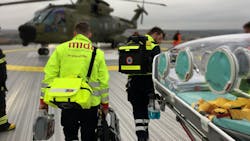New risks have Europe updating its civil defenses, but are nations rebuilding or reinventing?
Up-to-date civil defense can make a difference in saving lives in what might be a more likely CBRNe incident, like a terrorist bomb, a mishappen, a missile sent by a rogue state, or the use of chemical weapons by foreign nation intelligence.
In any CBRNe incident, first responders are at high risk. In many cases, emergency services are likely to be first in contact with an exposure, offering care before any threat is identified. Ordinary equipment like rubber gloves provide poor protection against nerve agents, and any rescue attempt can cause serious injuries.
Contrary to the Chemical Weapons Convention and international law, we have in recent years witnessed the use of chemical weapons both in the Syrian war and in civil society.
Rockets containing the chemical warfare agent sarin struck the city of Goutha, killing hundreds of people, including civilians. Moreover, those exposed to a non-lethal dose, who did not receive immediate medical treatment, suffer permanent neurological damage. Chemical warfare agents are designed specifically to not be detected by our senses. We can’t see them, we can’t smell them, so you don’t run away. Their toxicity is high enough that they have bad effects on your health already before you start feeling it, Ellen Cathrine Andersen, CEO in EpiGuard, explained.
Nerve agents and blister agents considered the ones most likely to be used in any terrorist action. In addition, the use of nerve agents in assassinations also impose a considerable risk.
Still, this is not what has nations doing civil defense inventory. The baseline risk of a nuclear scenario has increased, and as UN Secretary General António Guterres recently warned, “the prospect of nuclear war is now back within the realm of possibility.”
Russia’s invasion of Ukraine, and the threat of CBRN weapons in a conflict has led to a checkup on fallout shelters and a rush on anti-radiation potassium iodide pills. European countries fear of a nuclear catastrophe has governments reinventing civil defense, and not without reason. News reports of nuclear power plants taking heavy fire brings back memories of Ukrainian Chernobyl disaster in 1986. European leaders, which sit close to the battlefield, are doing a balance exercise of being alert and being alarmist.
A New Era of Civil Defense
When rebuilding stockpiles and emptying out old bomb shelters, modern civil defense and preparedness differs from Bert the turtle’s duck and cover. We see change along tree major axis that is technology, inclusion, and cooperation.
Technology
Along with the COVID pandemic, protective equipment technology has made a major leap forward. Technologies like modern isolation units keep first responders safe, while treating and transporting patients. New filter technology in e.g. the EpiShuttle protect health care takers from CBRN exposure.
The standard A2P3 filter will in addition to particles also filter organic gases and vapors with a boiling point above 65°C. This covers most of the warfare agents. If a CBRN filter is selected, also inorganic gases, ammonia and organic amines, and mercury compounds are covered. Today, there are a variety of different filters that can be selected for specific filtering, Ellen Cathrine Andersen, CEO in EpiGuard explains.
Moreover, information technology has always been at the center of any civil defense. Whether it be short wave radio or satellite. Elon Musk’s SpaceX just sent thousands of Starlink satellite internet dishes to Ukraine. Company President Gwynne Shotwell told the press that most of the funding for the Starlink kits has come from private sources. Which brings us to the second development, inclusion. Inclusion is more of a global development.
Inclusion
Along with the UN sustainable development goals, issues concerning a sustainable future went from being mostly a state matter, to include business, organizations, and the whole of society. The Nordic defense approach known as total preparedness is gaining momentum. The modernized total defense concept encompasses mutual support and cooperation between armed forces and civil society in connection with contingency planning, crisis management and consequence management across the entire crisis spectrum.
Cooperation
Cooperation is perhaps the most important development in civil defense. The recent pandemic proved rapid knowledge sharing and intergovernmental systems to establish relatively fast. Systems such as vaccine certificates is a result of increased cooperation.
Today, the EU plays a key role in coordinating the response to disasters in Europe and beyond. The rescEU reserve includes firefighting planes and helicopters, medical evacuation planes with EpiShuttles, as well as a stockpile of medical items. The EU Civil Protection Mechanism is currently channeling more than 100 million essential items in aid to Ukraine. Cooperation within the EU ensures a faster and more comprehensive response.
Moving forward, Europe is reinventing civil defense using new technology, including more of society, and cooperating amongst nations.



